Anemometers Introduced: Understanding Their Value in Environmental Surveillance and Security Measures
The duty of anemometers in environmental monitoring and precaution is often undervalued, yet their relevance is obvious. These instruments have a long history rooted in clinical query and technological advancements, progressing to come to be necessary devices in various fields. From weather forecasting to aviation security, anemometers play a critical function in giving precise data that informs decision-making procedures and enhances overall safety and security. Recognizing the complexities of anemometers unveils a globe of important insights that are basic to our understanding of the atmosphere and the procedures we take to make sure safety.
History of Anemometers
The evolution of anemometers can be traced back to the ancient civilizations where primary wind determining tools were initial used. These very early wind measurement tools laid the foundation for the advancement of extra innovative anemometers over time. One of the earliest known anemometers was the hemispherical cup anemometer designed by Leon Battista Alberti in the 15th century. This layout included 4 hemispherical mugs that accumulated wind power, giving a measurement of its strength based upon the speed of rotation.
Over the years, developments in innovation led to the advancement of even more modern anemometers, including ultrasonic anemometers and laser Doppler anemometers, offering enhanced accuracy and efficiency in gauging wind speed and direction. The history of anemometers showcases a remarkable trip of advancement and progression in the area of meteorology.
Kinds of Anemometers
Throughout the field of meteorology, numerous kinds of anemometers have actually been developed to precisely measure wind speed and instructions. Sonic anemometers utilize ultrasonic signals to gauge wind rate and direction properly. Hot-wire anemometers run based on the principle that the cooling effect of wind on a warmed cable is proportional to the wind rate.
Applications in Weather Forecasting
Having gone over the numerous kinds of anemometers made use of in weather forecasting for determining wind rate and instructions, it is vital to explore their practical applications in the area. Anemometers play a critical function in weather forecasting by providing precise and real-time data on wind conditions (anemometer). Meteorologists utilize anemometers to check wind speed and direction to forecast weather condition patterns, issue warnings for severe climate occasions like cyclones, storms, and twisters, and assess atmospheric problems for aeronautics safety
In weather forecasting, anemometers assist in comprehending regional and local wind patterns, which are important for anticipating weather adjustments and figuring out weather patterns. These gadgets are also utilized in research study to research microclimates, metropolitan warmth islands, and air pollution diffusion. Furthermore, anemometers are used in farming to maximize plant administration techniques, such as watering and pesticide application, based on wind problems.
Value in Aviation Safety And Security
An essential facet of ensuring air travel security depends on the meticulous surveillance of wind problems making use of anemometers. Anemometers play a crucial duty in air travel by offering real-time data on wind rate and direction, aiding pilots in making notified decisions during take-off, trip, and touchdown. Solid and unforeseeable winds can substantially influence airplane procedures, making it crucial for air travel authorities to count on precise wind measurements to make sure the safety of guests and crew.
:max_bytes(150000):strip_icc()/GettyImages-186864034-58e3355e5f9b58ef7e576b44.jpg)
In the dynamic setting of air travel, where even small modifications in wind rate and instructions can have extensive effects, anemometers stand as essential tools for advertising safe and risk-free air traveling.
Duty in Environmental Research
Anemometers play a crucial function in ecological research study by providing vital data on wind speed and instructions. By properly gauging wind features, anemometers assist researchers assess the motion of toxins in the air, analyze the effect of commercial emissions, and forecast the spread of pollutants in the environment.


Final Thought
In verdict, anemometers have actually played a critical duty in ecological tracking and precaution. With a rich background and different types readily available, these devices have actually been widely made use of in meteorology, find out aviation safety and security, and environmental research study. Understanding the importance of anemometers is crucial for precisely gauging wind speed and direction, which is vital for predicting weather condition patterns, making sure risk-free air travel procedures, and performing ecological research studies - anemometer. Their payments to these fields can not be ignored.
One of the earliest known anemometers was the hemispherical cup anemometer created by Leon Battista Alberti in the 15th century. Over the years, developments in innovation led to the advancement of even more modern anemometers, including ultrasonic anemometers and laser Doppler anemometers, using enhanced accuracy and efficiency in determining wind rate and instructions. Hot-wire anemometers operate based on the concept that the cooling result of wind on a warmed wire is symmetrical to the wind rate. Meteorologists use anemometers to keep track of wind rate and instructions to forecast weather patterns, problem cautions for severe climate occasions like tornadoes, storms, and cyclones, and assess atmospheric conditions for aviation safety and security.
Comprehending the relevance of anemometers is essential for properly gauging wind speed and instructions, which is crucial for predicting weather condition patterns, making sure risk-free see it here aeronautics procedures, and performing environmental research studies. (anemometer)
 Michael Bower Then & Now!
Michael Bower Then & Now! Michael Fishman Then & Now!
Michael Fishman Then & Now! Michael C. Maronna Then & Now!
Michael C. Maronna Then & Now! Nancy Kerrigan Then & Now!
Nancy Kerrigan Then & Now! McKayla Maroney Then & Now!
McKayla Maroney Then & Now!